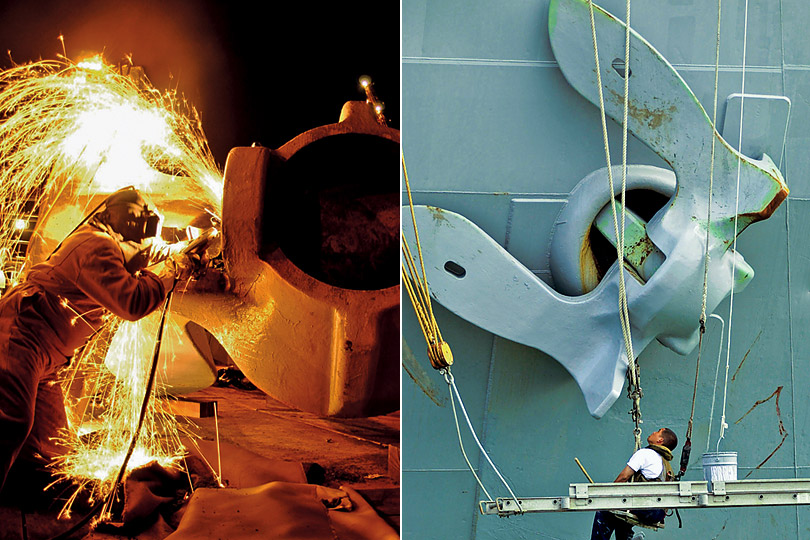Due to its strategic location along major shipping routes, the Singapore marine sector has long been a leading centre for ship repair.

From Strength to Strength
Since its humble beginnings, the Republic has grown to offer a comprehensive range of marine services, providing a one-stop marine centre for shipowners, managers and agents around the world.
Singapore’s marine and offshore industry is an important component of the economy. According to the Association of Singapore Marine Industries (ASMI), the industry managed to bring in a total turnover of S$15.3 billion in 2013, up 1.93 per cent from the year before, despite challenging market conditions. The sector was also responsible for the employment of some 109,700 workers in 2013.
The key activities of Singapore’s marine and offshore industry include shipyard operations, vessel design and marine supporting services. In recent years, the country has grown from strength to strength, becoming a global market leader in the building of jack-up rigs and conversion of Floating Production Storage Offloading (FPSO) units, in addition to ship repair. Singapore is also a niche player in the construction of customised and specialised vessels.
Amongst the companies in the marine and offshore sector in Singapore, two large shipyard groups stand out – Keppel Offshore & Marine and SembCorp Marine. The two dominate the local industry landscape and are the largest and second largest rig-builders in the world respectively. In addition, there is also a cluster of medium-sized shipyards, with varying capabilities for building and repairing of vessels.
Fortunes From Deep Waters
Major oil players have been venturing to offshore deep waters and harsh environments to drill for more oil, creating demand for new oil rigs with stringent and exacting specifications. With its reputation for consistent high quality and timely delivery, Singapore’s marine and offshore sector has benefited from this upturn in oil exploration and production (E&P) activities.
According to ASMI, the offshore rig building sector has grown the fastest in the recent years and accounts for a significant volume of work undertaken by the industry in general. In 2013, this sector generated a total turnover of S$9,717 million, up 7.0 per cent from the year before. This was also 63.5 per cent of the total turnover for the entire industry, a 3.0 per cent increase from 2012.
While there are concerns over the impact of record low oil prices on the oil and gas industry in the short term, the long-term outlook still remains in a good position. The Asia-Pacific is the fastest growing region in the world, backed by strong economic fundamentals and rapid economic growth. This will drive incremental energy demand, and expenditure on E&P activities. The region alone accounts for nearly a quarter of global E&P expenditure, which is expected to hit a record US$723 billion in 2014.
Setting Ships Sailing
Besides rig building, other areas of the marine and offshore sector, such as ship building, repair and conversion are also showing good progress. In ship building, Singapore has wisely built up its niche as specialist builders for smaller and customised vessels. Similarly, in ship repair and conversion, Singaporean players are moving more into niche market segments of LNG carriers, passenger ships, cruise ships and offshore support vessels.
In 2013, shipbuilding generated a total turnover of more than S$841 million. This was a decrease of 25.3 per cent from the turnover of S$1.1 billion earned in 2012. Meanwhile, for the same year, total turnover for ship repair and conversion was also an encouraging S$4.7 million.
Deep Knowledge and Talent
Looking forward, Singapore will continue to invest in research and development (R&D) and talent to create greater economic value add and ensure the competitiveness of the marine and offshore sector. For example, the Singapore Maritime Institute (SMI) has worked with industry players and institutes of higher learning to identify key research areas and tackle practical industry problems, such as exploration and production in harsher environments as well as asset integrity and risk management.
In the area of talent development, investments have been made to nurture a pool of industry-ready talent for the sector. Amongst the initiatives include the launch of the Subsea Professorships Programme and Petroleum Engineering Professorships Programme by the National University of Singapore (NUS) in 2012 and 2014 respectively, as Singapore looks to continue building up R&D capabilities and talent for the industry.
With a clear commitment to staying ahead through technology advancements and talent, allied its existing leadership position and natural advantages, Singapore’s marine and offshore sector looks set to benefit from strong regional fundamentals and power ahead in growth.